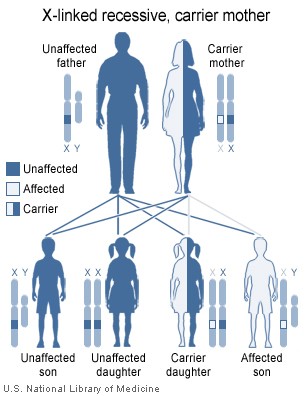Lesch-Nyhan syndrome pathophysiology
|
Lesch-Nyhan syndrome Microchapters |
|
Diagnosis |
|---|
|
Treatment |
|
Lesch-Nyhan syndrome pathophysiology On the Web |
|
American Roentgen Ray Society Images of Lesch-Nyhan syndrome pathophysiology |
|
Risk calculators and risk factors for Lesch-Nyhan syndrome pathophysiology |
Editor-In-Chief: C. Michael Gibson, M.S., M.D. [4]; Associate Editor(s)-in-Chief: Aarti Narayan, M.B.B.S [5]
Overview
It is an inborn error in purine metabolism resulting in deficiency of HGPRT enzyme, resulting in increased conversion of glycine to uric acid with excessive purine synthesis and hyperurecemia.
Pathophysiology

- HGPRT is the "salvage enzyme" for the purines: it channels adenosine (in its hypoxanthine form) and guanine back into DNA synthesis. Failure of this enzyme has two results:
- Cell breakdown products cannot be reused, and are therefore degraded. This gives rise to increased uric acid, a purine breakdown product.
- The de novo pathway is stimulated due to an excess of PRPP (5-phospho-D-ribosyl-1-pyrophosphate or simply phosphoribosyl-pyrophosphate).
- Patients have severe mental and physical problems throughout life. The lack of HGPRT causes a build-up of uric acid in all body fluids, and leads to problems such as severe gout, poor muscle control, and moderate mental retardation, which appear in the first year of life.
- A striking feature of LNS is self-mutilating behaviors, characterized by lip and finger biting, that begin in the second year of life.
- Abnormally high uric acid levels can cause sodium urate crystals to form in the joints, kidneys, central nervous system and other tissues of the body, leading to gout-like swelling in the joints and severe kidney problems.
- Neurological symptoms include facial grimacing, involuntary writhing, and repetitive movements of the arms and legs similar to those seen in Huntington's disease. The direct cause of the neurological abnormalities remains unknown. Polymorphisms for enzymes in the de novo pathway may contribute to the disease, but this would not be the case if uric acid neurotoxicity were the main cause of the symptoms.
- Moreover, evidence suggests that one or more lesions in striatal dopaminergic pathways is at least partially responsible for the neurological deficits, especially the choreoathetoid dyskinesia and self-mutilation.[1][2][3]. Thus, 6-hydroxydopamine toxicity in rodents is a useful animal model for the syndrome.[4] Another putative animal model, Hyperuricemic syndrome in Dalmatian dogs, presents with the characteristic arthritis and kidney failure, but not the neurological findings.
- Because a lack of HGPRT causes the body to poorly utilize vitamin B12, some boys may develop a rare disorder called megaloblastic anemia.
- The symptoms caused by the buildup of uric acid (arthritis and renal symptoms) respond well to treatment with drugs such as allopurinol that reduce the levels of uric acid in the blood.
- The mental deficits and self-mutilating behavior do not respond to treatment. There is no cure, but many patients live to adulthood.
Genetics
LNS is an X-linked recessive disease. The gene is carried by the mother and passed on to her son. LNS is present at birth in baby boys.

LNS is due to mutations in the HPRT1 gene,[5][6] so named because it codes for the enzyme hypoxanthine-guanine phosphoribosyltransferase (HPRT or HGPRT, EC 2.4.2.8). This enzyme is involved in the biochemical pathways the body uses to produce purines, one of the components of DNA and RNA. Defects of this enzyme lead to increased production of uric acid. Since the HPRT gene is located on the X chromosome, LNS is an X-linked inherited disease.
The father of an affected male will not be the carrier of the mutant allele, and will not have the disease. An obligate carrier would be a woman who has an affected son and one other affected relative in the maternal line.
If a woman is the first in her family with an affected son, Haldane's rule predicts a 2/3 chance that she is a carrier and a 1/3 chance that the son has a new germline mutation. However, in this case Haldane's prediction is incorrect due to an increased risk of mutation arising from the father when compared to the mother.
The risk to siblings of an affected individual depends upon the carrier status of the mother herself. A 50% chance is given to any female who is a carrier to transmit the HPRT1 mutation in each pregnancy. Sons who inherit the mutation will be affected while daughters who inherit the mutation are carriers. Therefore, with each pregnancy, a carrier female has a 25% chance of having a male that is affected, a 25% chance of having a female that is a carrier, and a 50% chance of having a normal male or female.
Males with LNS do not reproduce due to the characteristics of the disease. However, if a male with a less severe phenotype reproduces, all of his daughters are carriers, and none of his sons will be affected.
References
- ↑ [1]
- ↑ [2]
- ↑ Visser J, Smith D, Moy S, Breese G, Friedmann T, Rothstein J, Jinnah H (2002). "Oxidative stress and dopamine deficiency in a genetic mouse model of Lesch-Nyhan disease". Brain Res Dev Brain Res. 133 (2): 127–39. PMID 11882343.
- ↑ [3]
- ↑ Lesch-Nyhan syndrome. NCBI Genes and disease. Retrieved on 2007-04-12
- ↑ Lesch-Nyhan syndrome. Genetics Home Reference. Retrieved on 2007-05-24.